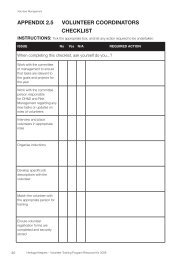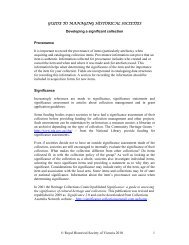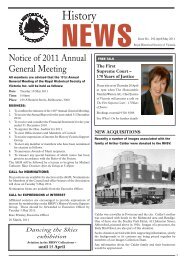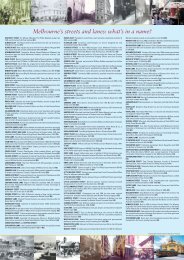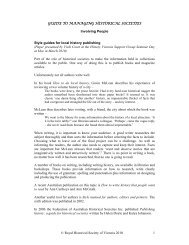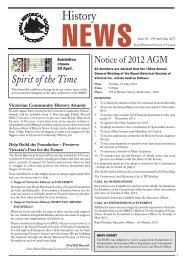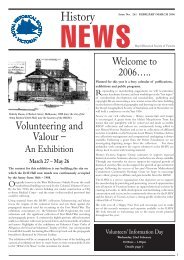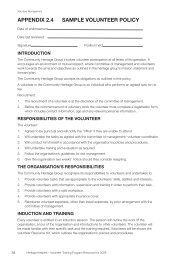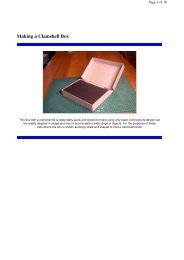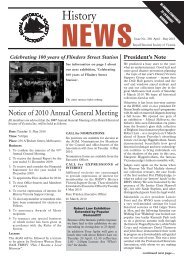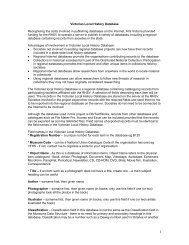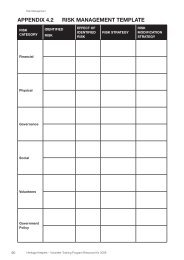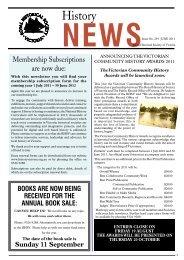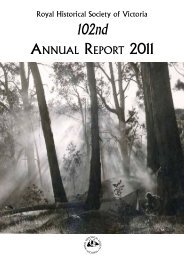RHSV History News June 2012 - Royal Historical Society of Victoria
RHSV History News June 2012 - Royal Historical Society of Victoria
RHSV History News June 2012 - Royal Historical Society of Victoria
Create successful ePaper yourself
Turn your PDF publications into a flip-book with our unique Google optimized e-Paper software.
BOOKS RECEIVED<br />
4<br />
BOOKS RECEIVED:<br />
We note below relevant items sent to the<br />
<strong>Society</strong>. Interested groups or authors are<br />
invited to contribute to this valuable service<br />
to members in <strong>History</strong> <strong>News</strong> and through<br />
possible deposit in the library. Some items may<br />
later be reviewed in the <strong>Victoria</strong>n <strong>Historical</strong><br />
Journal.<br />
Katherine Sheedy, The Act <strong>of</strong> Nursing,<br />
A <strong>History</strong> <strong>of</strong> Nursing Regulation in<br />
<strong>Victoria</strong>, Nurses Board <strong>of</strong> <strong>Victoria</strong> Legacy<br />
Limited (Available from the Nurses<br />
Memorial Centre, Suite 11/431 St Kilda<br />
Road, Melbourne), 2011, pp. xiv + 208<br />
State regulation <strong>of</strong> nursing and midwifery in<br />
<strong>Victoria</strong> started in 1923 and ended in 2010.<br />
The period marks the development <strong>of</strong> nursing<br />
as a pr<strong>of</strong>ession, the growth <strong>of</strong> tertiary-based<br />
courses and the advent <strong>of</strong> a national registration<br />
scheme. This book amply charts the work <strong>of</strong><br />
the bodies and individuals that administered<br />
regulation through nursing boards and<br />
councils. Elegantly produced with many<br />
evocative photos.<br />
Norman Houghton, A Gentle Place,<br />
The Geelong Club – A Jubilee <strong>History</strong><br />
1859 to 2009, Norman Houghton, PO<br />
Box 1128, Geelong, <strong>2012</strong>, pp. iv + 82.<br />
The early years <strong>of</strong> this gentleman’s club in<br />
Geelong were faltering and it was not until<br />
1881 that the Club achieved some permanence<br />
with a new purpose-built house opened in<br />
1889. The book charts the ways in which the<br />
Club was managed, changes in the use <strong>of</strong> the<br />
premises, key personnel, and social events. It<br />
will doubtless be well-received by members.<br />
There are statements about its importance –<br />
‘one <strong>of</strong> the foundation blocks <strong>of</strong> the Geelong<br />
community’ according to the foreword. But<br />
apart from noting prominent members <strong>of</strong><br />
the community, there is little discussion <strong>of</strong><br />
its impact on Geelong. For example, the<br />
impact <strong>of</strong> the collapse <strong>of</strong> Pyramid in 1990 on<br />
membership is mentioned, but not any part<br />
that might have been played by Club members.<br />
Questions about its place in the history <strong>of</strong><br />
Geelong are for another book.<br />
Mick Woiwood (ed.), The Diary <strong>of</strong><br />
Andrew Ross, 1828-1895 & The<br />
Reminiscences <strong>of</strong> Andrew Ross, 1851-<br />
1864, Tarcoola Press in association with<br />
Andrew Ross Museum, PO Box 1232,<br />
Kangaroo Ground, 3097, 2011, pp. 235 + 128<br />
Ross kept a meticulous diary for 67 years. It<br />
has been in the State Library since 1985. This<br />
publication brings it and some reminiscences<br />
written for the Evelyn Observer after he returned<br />
to England in 1876 where he died in 1895.<br />
For most <strong>of</strong> the time he spent in the Port<br />
Phillip District/<strong>Victoria</strong>, he lived at Kangaroo<br />
Ground where he was the leading figure in<br />
its social and cultural life. Always in financial<br />
difficulties, he was teacher, Presbyterian pastor,<br />
organizer, civic <strong>of</strong>ficial as well as entrepreneur<br />
in a succession <strong>of</strong> largely unsuccessful ventures.<br />
Both the diaries and the reminiscences are rich<br />
in their detail about a small community on the<br />
outskirts <strong>of</strong> Melbourne in the Yarra Valley. They<br />
are well indexed in this attractively produced<br />
volume.<br />
Anne Marsden, The Marsdens <strong>of</strong><br />
Melbourne, The rise and fall <strong>of</strong> a family’s<br />
fortunes 1841-1941, Marsden Publishing,<br />
Melbourne, 272-310 Pigdon Street,<br />
Carlton North, 3054, 2009, pp. xii + 243<br />
A well-presented, well-researched family<br />
history covering three generations <strong>of</strong> Marsden<br />
– Joseph (1811-1889), Wesleyan preacher and<br />
social activist in early Melbourne (he arrived in<br />
1841); his son, John (1844-1913) who became<br />
Chief Government Architect in <strong>Victoria</strong>;<br />
and his son, Edgar (1880-1957) described<br />
as singer, soldier and cricketer. In addition,<br />
there are vignettes about their wives and<br />
John’s sister, Sarah Whiting. Each <strong>of</strong> the men’s<br />
lives has wider than family interest: John’s<br />
activism in early Melbourne is well-recorded<br />
and says much about the settlement; Joseph’s<br />
architectural output includes a number <strong>of</strong><br />
grand post <strong>of</strong>fices as well as Ballarat High<br />
School and the Melbourne Teachers’ College,<br />
now part <strong>of</strong> the University <strong>of</strong> Melbourne; and<br />
Edgar’s pr<strong>of</strong>essional and considerable singing<br />
career and interest in cricket, including the<br />
touring Fijian team in 1907-8. Well-indexed.<br />
John Ramsland, Cook’s Hill Life Saving<br />
& Surf Club, The First Hundred Years,<br />
Brolga, Melbourne, 2011, pp. xi + 339<br />
The advent <strong>of</strong> surfing early last century and the<br />
rise <strong>of</strong> clubs and association and competitions<br />
has meant a crop <strong>of</strong> centenary histories <strong>of</strong> clubs<br />
especially around Sydney, but also in Newcastle<br />
where Cook’s Hill is a southern suburb. This<br />
book serves parochial interests very well in<br />
documenting for members its illustrious past,<br />
even including a list <strong>of</strong> members’ sobriquets.<br />
But it does more because it supplies a context<br />
for the development <strong>of</strong> the club and surfing<br />
generally in Australian society, something <strong>of</strong>ten<br />
lacking in sporting club histories.<br />
Richard Gillespie, The Great<br />
Melbourne Telescope, Museum<br />
<strong>Victoria</strong>, Melbourne, 2011, pp. 188<br />
A thorough narrative that details the design,<br />
manufacture, and eventual installation <strong>of</strong> the<br />
Great Melbourne Telescope at the Melbourne<br />
Observatory in 1869, through all the difficulties<br />
<strong>of</strong> lobbying, initially by William Wilson, the<br />
foundation pr<strong>of</strong>essor <strong>of</strong> mathematics at the<br />
university, and erection in Melbourne where<br />
it took time to get the telescope working under<br />
Ellery’s direction. A technological marvel <strong>of</strong><br />
its age, the telescope was eventually removed<br />
in 1945 to the Mount Stromlo Observatory<br />
in Canberra where it was modernized and<br />
re-erected and had a second life until the<br />
Canberra fires <strong>of</strong> 2003. Its remnants have<br />
now been assembled in Melbourne where it<br />
is hoped to restore this important piece <strong>of</strong><br />
scientific heritage and give it a third life. A<br />
masterly text that deals with complex technical<br />
material in a readily understandable way.<br />
Allan Mawdsley, Such Big Work, The<br />
life <strong>of</strong> Alice Isabel Hay Creswick, OBE<br />
DstJ, Allan Mawdsley, 92 Armstrong<br />
Street, Middle Park 3206, 2011, pp. 220<br />
A substantial biography <strong>of</strong> Alice Creswick<br />
(1889-1973). Born into a wealthy Scottish<br />
family, in 1910 Alice (nee Reid) married Harry<br />
Creswick (1886-1935), scion <strong>of</strong> a wealthy<br />
Australian pastoral family, and came to live<br />
in <strong>Victoria</strong>, mostly in Melbourne. Important<br />
socially, she joined the committee <strong>of</strong> the Lady<br />
Northcote Kindergarten in 1928 and soon<br />
became president. After the tragic death <strong>of</strong> her<br />
husband, Alice was active in the management<br />
<strong>of</strong> the family properties and became president<br />
<strong>of</strong> the Free Kindergarten Union in 1939.<br />
At the same time, she was co-opted to the<br />
Central Council <strong>of</strong> the Australian Red Cross<br />
as it prepared for the war, becoming Principal<br />
Commandant <strong>of</strong> Service Corps personnel in<br />
1941. An engaging biography, well-illustrated<br />
and providing details about a very capable<br />
woman and her important works and contacts.<br />
John Ramsland, From Antarctica to the<br />
Gold Rushes in the wake <strong>of</strong> the ‘Erebus’,<br />
Brolga, Melbourne, 2011, pp. xii + 376. After<br />
service in the <strong>Royal</strong> Navy including voyages<br />
to the Antarctic in the early 1840s, Alexander<br />
Smith (1812-1872) briefly migrated to<br />
Tasmania as naval <strong>of</strong>ficer at the Rossbank<br />
Observatory in Hobart. After returning to<br />
England and retirement from the navy, Smith<br />
was appointed as Goldfields Commissioner<br />
<strong>of</strong> Crown Lands at Castlemaine, taking up his<br />
position in 1853 and later entering parliament.<br />
The book mainly deals with the Antarctic<br />
voyages but also is a pioneering biography<br />
that brings a largely unknown life <strong>of</strong> interest to<br />
Antarctic exploration, as well as colonial life in<br />
<strong>Victoria</strong> in the aftermath <strong>of</strong> gold using hitherto<br />
privately held papers.<br />
Peter Yule, William Lawrence Baillieu,<br />
Founder <strong>of</strong> Australia’s Greatest Business<br />
Empire, Hardie Grant, Melbourne<br />
and London, <strong>2012</strong>, pp. viii + 423, $65<br />
‘Big Bill’ Baillieu, a very significant figure in<br />
Australian business, has lacked a biography until<br />
this one that establishes the drive and expertise<br />
that made him an extremely powerful force in<br />
20 th century Australian business and politics.<br />
Always tainted by his failure and contributing<br />
doubtful practices in the Melbourne ‘land<br />
boom’ <strong>of</strong> the 1880s, ‘WL’ was one <strong>of</strong> the few<br />
survivors who re-established their wealth and<br />
power in subsequent decades. Theodore Fink<br />
and ‘Tommy’ Bent did likewise. Baillieu largely<br />
eschewed Melbourne society and headed up<br />
an empire that supported and was assisted<br />
by his large family. All these ventures are<br />
carefully charted by the author to reveal the<br />
range <strong>of</strong> his astounding enterprise: real estate,<br />
gold mining, share trading, mining and metal<br />
industries, farming. Most importantly his<br />
role in developing the Collins House group<br />
along with his part in establishing the rise <strong>of</strong><br />
mega-companies like Rio Tinto, the Herald &<br />
Weekly Times, Electrolytic Zinc, Dunlop and<br />
Carlton & United Breweries make him the<br />
business titan suggested by the book’s sub-title.



